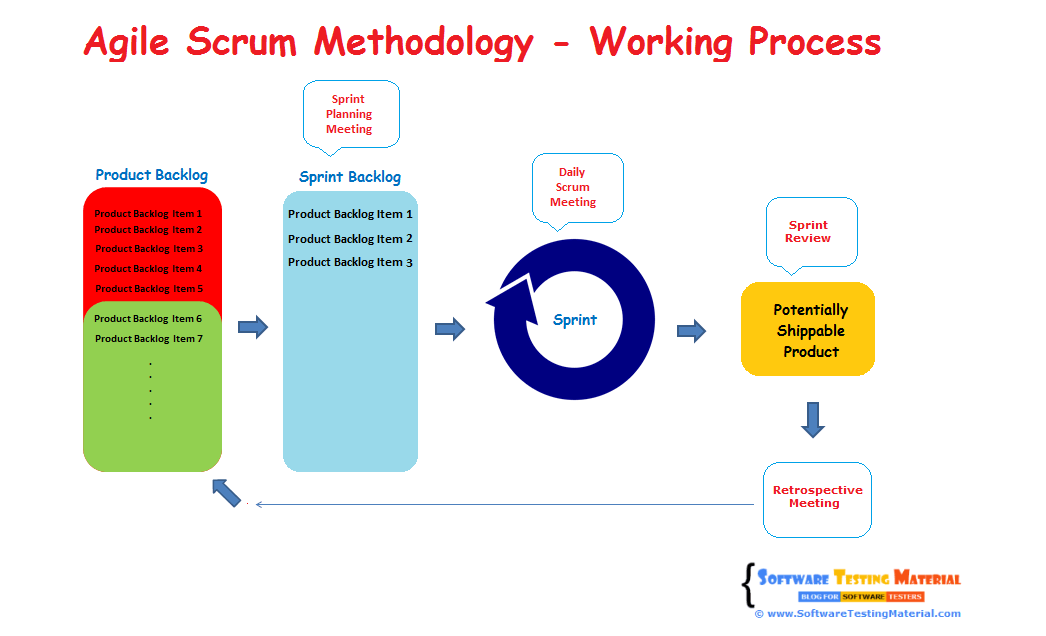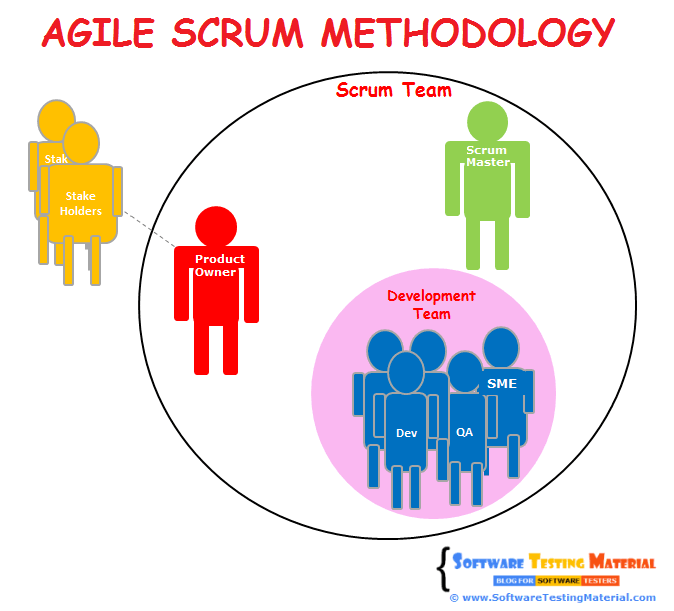Agile Scrum Methodology In Software Development
Agile Scrum Methodology is one of the popular Agile software development methods. There are some other Agile software development methods but the popular one which is using widely is Agile Scrum Methodology. The Agile Scrum Methodology is a combination of both Incremental and Iterative model for managing product development.

In Scrum, the project is divided into Sprints.
Sprint: Each Sprint has a specified timeline (2 weeks to 1 month). This timeline will be agreed upon by a Scrum Team during the Sprint Planning Meeting. Here, User Stories are split into different modules. End result of every Sprint should be a potentially shippable product.
The three important aspects involved in Scrum such as Roles, Artifacts and Meetings:
Mục lục bài viết
ROLES IN AGILE SCRUM METHODOLOGY:
Product Owner:
The Product Owner usually represents the Client and acts as a point of contact from the Client side. The one who prioritizes the list of Product Backlogs that Scrum Team should finish and release.
Scrum Master:
Scrum Master acts as a facilitator to the Scrum Development Team. Clarifies the queries and organizes the team from distractions and teaches team how to use scrum and also concentrates on Return on Investment (ROI).
Scrum Development Team:
Developer’s, QA’s. Who develops the product. The Scrum development team decides the effort estimation to complete a Product Backlog Item.
Scrum Team:
A cross-functional, self-organizing group of dedicated people (Group of Product Owner, Business Analyst, Developer’s and QA’s). The recommended size of a scrum team is 7 plus or minus 2 (i.e, between 5 to 9 members in a team)

ARTIFACTS IN AGILE SCRUM METHODOLOGY:
User Stories:
User Stories are not like traditional requirement documents. In User Stories, stakeholders mention what features they need and what they want to achieve.
Product Backlog:
Product Backlog is a repository where the list of Product Backlog Items stored and maintained by the Product Owner. The list of Product Backlog Items is prioritized by the Product Owner as high and low and also could re-prioritize the product backlog constantly.
Sprint Backlog:
Group of user stories which scrum development team agreed to do during the current sprint (Committed Product Backlog items)
Product Burndown Chart:
A graph that shows how many Product Backlog Items (User Stories) implemented/not implemented.
Sprint Burndown Chart:
A graph which shows how many Sprints implemented/not implemented by Scrum Team.
Release Burndown Chart:
A graph that shows a List of releases still pending, which the Scrum Team has planned.
Defect Burndown Chart:
A graph that shows how many defects identified and fixed.
Note: Burn Down Charts provide proof that the project is on track or not.
MEETINGS IN AGILE SCRUM METHODOLOGY:
Sprint Planning Meeting:
The first step of Scrum is Sprint Planning Meeting where the entire Scrum Team attends. Here the Product Owner selects the Product Backlog Items (User Stories) from the Product Backlog.
Most important User Stories at the top of the list and least important User Stories at the bottom. Scrum Development Team decides and provides the effort estimation.
Daily Scrum Meeting: (Daily Stand-up)
Daily Scrum is also known as Daily Stand-up meeting. Here each team member reports to the peer team member on what he/she did yesterday, what he/she going to do today and what obstacles are impeding in their progress. Reporting will be between peers not to Scrum Master or Product Owner. Daily Scrum will be approximately 15 mins.
Sprint Review Meeting:
In the Sprint Review Meeting, Scrum Development Team presents a demonstration of a potentially shippable product. Product Owner declares which items are completed and not completed. Product Owner adds the additional items to the product backlog based on the stakeholder’s feedback.
Sprint Retrospective Meeting:
Scrum Team meets again after the Sprint Review Meeting and documents the lessons learnt in the earlier sprint such as “What went well”, “What could be improved”. It helps the Scrum Team to avoid mistakes in the next Sprints.
When do we use Agile Scrum Methodology?
The client is not so clear on the requirements
The client expects quick releases
The client doesn’t give all the requirements at a time
Conclusion:
In an Agile Scrum Methodology, all the members in a Scrum Team gathers and finalize the Product Backlog Items (User Stories) for a particular Sprint and commit the timeline to release the product. Based on the Daily Scrum meetings, Scrum Development Team develops and tests the product and presents it to the Product Owner at Sprint Review Meeting. If the Product Owner accepts all the developed User Stories then the Sprint is completed and the Scrum Team goes for the next Sprint in a same manner.
I have posted a list of “20 Agile Testing Interview Questions”. If you haven’t gone through it, you can browse by clicking on the link.











